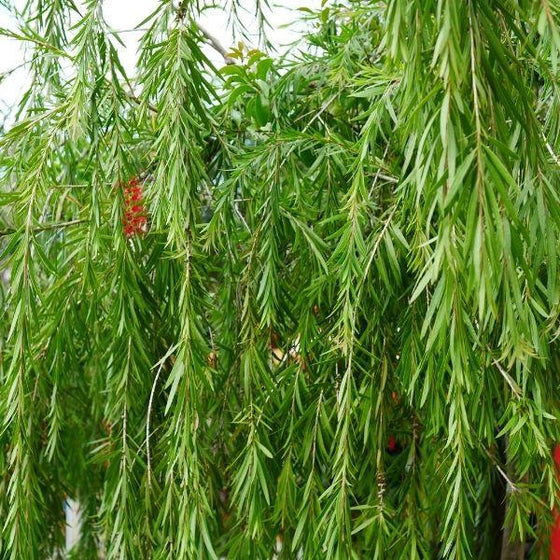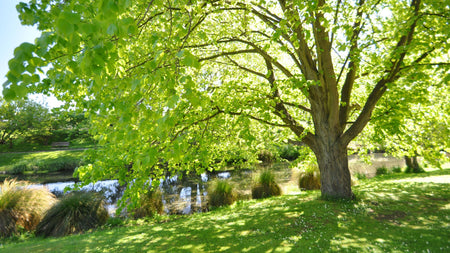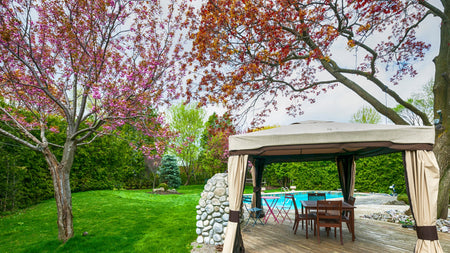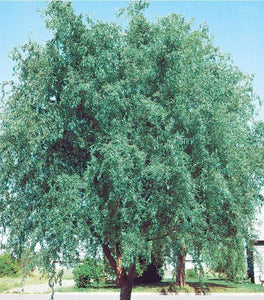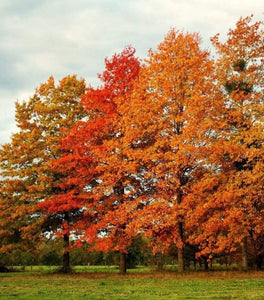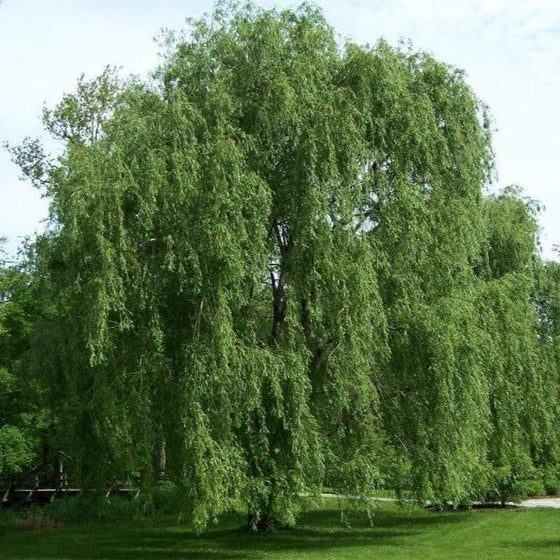
Images Depict Mature Plants
Weeping Willow Tree
The Weeping Willow Tree (Salix babylonica) is a timeless landscape favorite, beloved for its graceful, cascading branches and lush, lance-shaped green foliage. Its iconic silhouette adds elegance and tranquility to any outdoor space, making it a stunning focal point in large lawns, near water features, or along property edges. In spring and summer, its long, sweeping branches sway gently in the breeze, creating a peaceful, romantic ambiance. This fast-growing deciduous tree reaches heights of 30 to 50 feet with a wide, arching canopy spread of 30 to 40 feet, providing excellent shade and visual impact.
Weeping Willows thrive in full sun and moist, well-drained soils, though they are especially suited for planting near ponds, lakes, or rivers where their roots can access consistent moisture. Their rapid growth rate and adaptability to different soil types make them a practical and visually striking choice for erosion control on slopes or in wet areas. While they require space to accommodate their expansive canopy and shallow root system, these trees are remarkably low-maintenance once established and can quickly transform open landscapes into serene, park-like settings.
Whether you’re designing a peaceful backyard retreat or looking to soften a large open area with movement and texture, the Weeping Willow Tree delivers unmatched elegance and shade. Its timeless beauty and fast growth make it ideal for large residential properties, estates, and rural landscapes. Plant this graceful tree where it has room to grow, and enjoy year-round visual interest, cooling shade, and the gentle, weeping charm that has made this willow a landscape icon for generations.
Weeping willow trees can also provide essential habitats for various wildlife species. Birds, insects, and small mammals often find shelter and food among the tree's branches and leaves. By planting a weeping willow, you can help support local ecosystems and encourage biodiversity in your area.
Salix Babylonica, commonly known as the Babylon weeping willow, is one of the most popular varieties of Weeping Willow Trees. It features long, sweeping branches and bright green leaves that turn golden yellow in the fall. This tree can grow up to 50 feet tall, making it a striking addition to any landscape. Hardy to USDA zones 6-8, the Weeping Willow is widely used as an ornamental tree in parks and gardens around the world.

| Hardiness Zone: | 6-8 |
|---|---|
| Mature Height: | 35 to 50 feet |
| Mature Width: | 35 to 50 feet |
| Classification: | Broad Leaved deciduous tree, Shade Tree |
| Sunlight: | Full Sun |
| Habit: | Upright |
| Foliage: | Dark Green, golden yellow fall color |
| Flower Color: | Drooping Catkins |
| Pruning Season: | Tolerates hard pruning |
| Soil Condition: | Any well drained soil |
| Water Requirements: | Water well until established |
| Uses: | Tolerates moist soil and full sun. Full sun brings out the best fall color. Will adapt to drier sites |
How to Care for Weeping Willow Tree
Be sure to read our planting instructions to ensure a healthy and happy Weeping Willow Tree for years to come!
How Should I Plant My Weeping Willow Tree?
To plant your Weeping Willow Tree successfully, choose a location with full sun and ample space, as these trees can grow 30 to 50 feet tall with a 30 to 40-foot spread. Ideally, select a site near a pond, stream, or other water source where the soil remains consistently moist but well-drained. Begin by digging a hole twice as wide and just as deep as the tree’s root ball. Place the tree in the hole so that the top of the root ball is level with the surrounding soil, then backfill with native soil, gently firming as you go to eliminate air pockets. Water thoroughly after planting to help the roots settle and establish strong contact with the soil. Be sure to allow plenty of space between your Weeping Willow Tree and structures like sidewalks, septic systems, or building foundations, as their shallow, widespread roots can interfere with nearby infrastructure. Adding a 2–3 inch layer of mulch around the base of the tree will help retain moisture, regulate soil temperature, and suppress weeds, but keep the mulch a few inches away from the trunk to prevent rot. With the right location and proper planting technique, your Weeping Willow will quickly establish itself and create a stunning, flowing canopy that brings shade, movement, and beauty to your landscape.
How Should I Water My Weeping Willow Tree?
Watering your Weeping Willow Tree properly is essential, especially during the first few years as the tree establishes its expansive root system. Newly planted Weeping Willows should be watered deeply two to three times per week, ensuring that the moisture reaches the full depth of the root ball. As these trees prefer moist soil, keeping the area consistently damp but not waterlogged will encourage strong, healthy growth. Using a soaker hose or slow drip system at the base of the tree helps deliver water efficiently and prevents runoff, giving your Weeping Willow the hydration it needs to develop its iconic cascading canopy. Once established, Weeping Willow Trees generally require less frequent watering, relying on natural rainfall and nearby water sources if planted near ponds or streams. During periods of drought or extremely hot weather, deep watering once a week will keep the tree healthy and vibrant. Mulching around the base helps retain soil moisture and reduces watering needs. Proper watering not only supports rapid growth but also maintains the tree’s lush green foliage and graceful weeping form, ensuring your Weeping Willow remains a stunning, serene centerpiece in the landscape.
How Should I Fertilize My Weeping Willow Tree?
Fertilizing your Weeping Willow Tree properly helps promote fast, healthy growth, lush foliage, and a strong, graceful canopy. In early spring, apply a balanced slow-release fertilizer, such as a 10-10-10 or 20-20-20 formula, around the base of the tree, keeping it several inches away from the trunk. Spread the fertilizer evenly across the root zone, then water thoroughly to help the nutrients penetrate the soil and reach the roots. This feeding provides essential nutrients right as the tree begins its vigorous spring growth, encouraging a full, cascading form and strong branch structure. For mature Weeping Willow Trees, fertilizing once a year in early spring is usually sufficient to maintain health and vitality. In nutrient-poor soils, a second light feeding in mid-summer can support continued growth and stress resistance, especially during hot, dry periods. Organic options like composted manure or a layer of rich organic mulch can also be applied around the root zone to slowly improve soil quality over time. Proper fertilization helps ensure your Weeping Willow maintains its rapid growth rate, lush green leaves, and signature weeping shape, making it a breathtaking centerpiece in large landscapes and waterside plantings.

How and When Should I Prune My Weeping Willow Tree?
Pruning your Weeping Willow Tree is important for maintaining its graceful form, encouraging strong branch structure, and promoting long-term health. The best time to prune a Weeping Willow is in late winter or early spring, while the tree is still dormant and before new growth begins. Start by removing any dead, damaged, or diseased branches to prevent the spread of pests and diseases. Focus on thinning out crowded areas to improve airflow and light penetration, which helps prevent fungal issues. Use clean, sharp pruning tools and make clean cuts just outside the branch collar for best healing results. Light pruning can also be done during the summer months if you need to remove any low-hanging or broken branches that interfere with foot traffic or structures. Be careful not to over-prune, as Weeping Willows are fast growers and can stress if too much foliage is removed at once. Regular annual pruning keeps your Weeping Willow looking elegant, with its characteristic cascading canopy, and helps maintain a strong, stable framework that can better withstand storms and heavy winds. With proper timing and technique, your Weeping Willow Tree will remain a breathtaking focal point in your landscape for decades.

